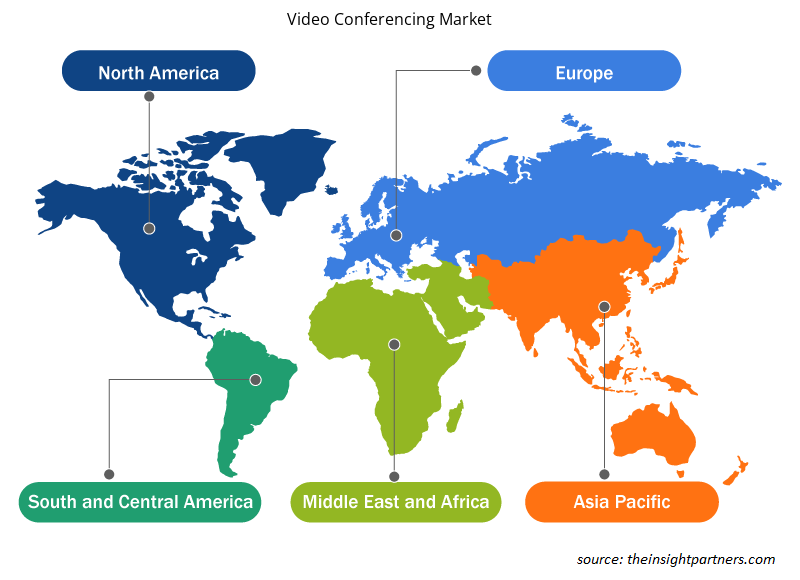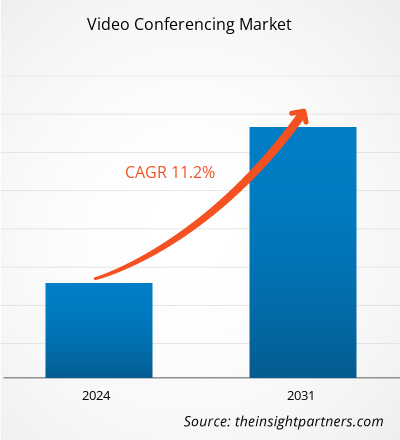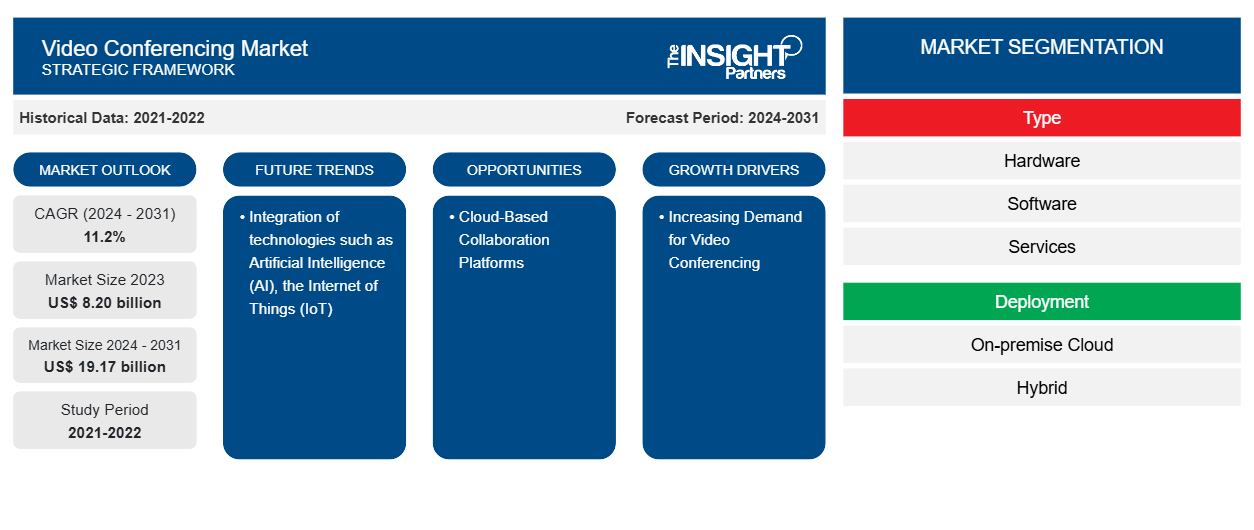Der globale Markt für Videokonferenzen soll von 8,20 Milliarden US-Dollar im Jahr 2023 auf 19,17 Milliarden US-Dollar im Jahr 2031 wachsen; von 2024 bis 2031 wird eine durchschnittliche jährliche Wachstumsrate von 11,2 % erwartet. Die Integration von Technologien wie künstliche Intelligenz (KI), das Internet der Dinge (IoT) und Cloud-Technologie dürften weiterhin wichtige Trends auf dem Markt für Videokonferenzen bleiben.
Videokonferenz-Marktanalyse
Der Anstieg von Remote-Arbeit und virtuellen Teams hat die Nachfrage nach Videokonferenzlösungen angeheizt. Videokonferenzen ermöglichen eine effektive Kommunikation und Zusammenarbeit zwischen geografisch verteilten Teams, was zu einer zunehmenden Akzeptanz in Organisationen führt.
Marktübersicht für Videokonferenzen
Videokonferenzen sind ein leistungsstarkes Tool, mit dem Einzelpersonen und Teams unabhängig von ihrem physischen Standort eine Verbindung herstellen und zusammenarbeiten können. Dabei werden Audio- und Videotechnologien genutzt, um virtuelle Meetings zu erstellen, bei denen die Teilnehmer in Echtzeit kommunizieren können, als wären sie im selben Raum. Diese Technologie hat die Arbeitsweise von Unternehmen revolutioniert, indem sie eine nahtlose Kommunikation ermöglicht, die Produktivität steigert und die globale Zusammenarbeit fördert. In der schnelllebigen Geschäftswelt sind Videokonferenzen zu einem unverzichtbaren Tool für Organisationen jeder Größe geworden. Sie beseitigen die Barrieren von Entfernung und Zeit und ermöglichen es Fachleuten, persönliche Meetings abzuhalten, ohne reisen zu müssen. Dies spart nicht nur wertvolle Zeit, sondern reduziert auch die Kosten für Transport, Unterkunft und andere logistische Ausgaben.
Passen Sie diesen Bericht Ihren Anforderungen an
Sie erhalten kostenlose Anpassungen an jedem Bericht, einschließlich Teilen dieses Berichts oder einer Analyse auf Länderebene, eines Excel-Datenpakets sowie tolle Angebote und Rabatte für Start-ups und Universitäten.
-
Holen Sie sich die wichtigsten Markttrends aus diesem Bericht.Dieses KOSTENLOSE Beispiel umfasst eine Datenanalyse von Markttrends bis hin zu Schätzungen und Prognosen.
Treiber und Chancen auf dem Videokonferenzmarkt
Steigende Nachfrage nach Videokonferenzen begünstigt den Markt
Die Nachfrage nach Videokonferenzlösungen ist in den letzten Jahren stetig gestiegen. Dieses Wachstum ist auf mehrere Faktoren zurückzuführen, darunter die Notwendigkeit visueller Meetings und Zusammenarbeit in Echtzeit zwischen Einzelpersonen und Teams. Der aufkommende Trend zur Fernarbeit und zu geografisch verstreuten Geschäftstätigkeiten hat zur erhöhten Nachfrage nach Videokonferenzlösungen beigetragen. Da immer mehr Menschen von zu Hause oder an verschiedenen Standorten aus arbeiten, bieten Videokonferenzen eine bequeme und effiziente Möglichkeit, sich zu vernetzen und zusammenzuarbeiten. Videokommunikationslösungen ermöglichen es großen Unternehmen, ihre Betriebseffizienz zu verbessern und ein besseres Kundenerlebnis zu bieten. Diese Lösungen fördern die Zusammenarbeit zwischen Mitarbeitern an verschiedenen Standorten und ermöglichen eine nahtlose Zusammenarbeit der Teams.
Cloudbasierte Kollaborationsplattformen
Cloudbasierte Kollaborationsplattformen erfreuen sich bei Unternehmen und Organisationen aufgrund ihrer Flexibilität, Skalierbarkeit und Benutzerfreundlichkeit zunehmender Beliebtheit. Diese Plattformen nutzen Cloud-Technologie, um Echtzeitkommunikation , Dokumentenaustausch und Projektmanagement zu ermöglichen. Cloud-Kollaborationsplattformen ermöglichen Teammitgliedern die Zusammenarbeit und den sofortigen Austausch von Ideen durch Echtzeitkommentare, Chat und Videokonferenzen. Diese Flexibilität ermöglicht es Teams, unabhängig von ihrem physischen Standort zusammenzuarbeiten, was die effektive Zusammenarbeit von Remote-Teams oder Teams in verschiedenen Städten erleichtert.
Segmentierungsanalyse des Marktberichts für Videokonferenzen
Schlüsselsegmente, die zur Ableitung der Marktanalyse für Videokonferenzen hinsichtlich Typ, Einsatz und Branche beigetragen haben.
- Nach Typ ist der Markt in Hardware, Software und Dienstleistungen unterteilt. Das Hardwaresegment hatte im Jahr 2023 einen größeren Marktanteil.
- Basierend auf der Bereitstellung ist der Markt in On-Premise-Cloud und Hybrid unterteilt. Das On-Premise-Segment hatte im Jahr 2023 einen größeren Marktanteil.
- Basierend auf der Branchenvertikale ist der Markt in Unternehmensunternehmen, Regierung und Verteidigung, Gesundheitswesen, Bildung, Fertigung und andere unterteilt. Das Segment der Unternehmensunternehmen hatte im Jahr 2023 einen größeren Marktanteil.
Videokonferenz-Marktanteilsanalyse nach geografischer Lage
Der geografische Umfang des Marktberichts für Videokonferenzen ist hauptsächlich in fünf Regionen unterteilt: Nordamerika, Asien-Pazifik, Europa, Naher Osten und Afrika sowie Südamerika/Süd- und Mittelamerika. Nordamerika dominierte den Markt für Videokonferenzen im Jahr 2023. Die Präsenz großer Windparks und großer Solarstromprojekte in Nordamerika hat zum Wachstum des IGBT-Marktes beigetragen. IGBTs werden in Stromrichtern für erneuerbare Energiesysteme wie Windturbinen und Solarwechselrichtern verwendet.
Regionale Einblicke in den Videokonferenzmarkt
Die regionalen Trends und Faktoren, die den Videokonferenzmarkt im Prognosezeitraum beeinflussen, wurden von den Analysten von Insight Partners ausführlich erläutert. In diesem Abschnitt werden auch die Marktsegmente und die Geografie des Videokonferenzmarkts in Nordamerika, Europa, im asiatisch-pazifischen Raum, im Nahen Osten und Afrika sowie in Süd- und Mittelamerika erörtert.

- Holen Sie sich die regionalen Daten für den Videokonferenzmarkt
Umfang des Marktberichts für Videokonferenzen
| Berichtsattribut | Details |
|---|---|
| Marktgröße im Jahr 2023 | 8,20 Milliarden US-Dollar |
| Marktgröße bis 2031 | 19,17 Milliarden US-Dollar |
| Globale CAGR (2024 - 2031) | 11,2 % |
| Historische Daten | 2021-2022 |
| Prognosezeitraum | 2024–2031 |
| Abgedeckte Segmente |
Nach Typ
|
| Abgedeckte Regionen und Länder |
Nordamerika
|
| Marktführer und wichtige Unternehmensprofile |
|
Marktteilnehmerdichte: Der Einfluss auf die Geschäftsdynamik
Der Markt für Videokonferenzen wächst rasant, angetrieben durch die steigende Nachfrage der Endnutzer aufgrund von Faktoren wie sich entwickelnden Verbraucherpräferenzen, technologischen Fortschritten und einem größeren Bewusstsein für die Vorteile des Produkts. Mit steigender Nachfrage erweitern Unternehmen ihr Angebot, entwickeln Innovationen, um die Bedürfnisse der Verbraucher zu erfüllen, und nutzen neue Trends, was das Marktwachstum weiter ankurbelt.
Die Marktteilnehmerdichte bezieht sich auf die Verteilung von Firmen oder Unternehmen, die in einem bestimmten Markt oder einer bestimmten Branche tätig sind. Sie gibt an, wie viele Wettbewerber (Marktteilnehmer) in einem bestimmten Marktraum im Verhältnis zu seiner Größe oder seinem gesamten Marktwert präsent sind.
Die wichtigsten auf dem Videokonferenzmarkt tätigen Unternehmen sind:
- Adobe Systems Inc.
- Zoom
- Avaya Inc.
- Cisco Systems Inc.
- Huawei Investment und Holding Co., Ltd.
Haftungsausschluss : Die oben aufgeführten Unternehmen sind nicht in einer bestimmten Reihenfolge aufgeführt.

- Überblick über die wichtigsten Akteure auf dem Videokonferenzmarkt
Neuigkeiten und aktuelle Entwicklungen zum Videokonferenzmarkt
Der Videokonferenzmarkt wird durch die Erhebung qualitativer und quantitativer Daten nach Primär- und Sekundärforschung bewertet, die wichtige Unternehmensveröffentlichungen, Verbandsdaten und Datenbanken umfasst. Im Folgenden finden Sie eine Liste der Entwicklungen auf dem Markt:
- Im März 2024 führte Google Meet eine hochmoderne Funktion zur Porträtretusche ein, die speziell für virtuelle Meetings entwickelt wurde. Diese innovative Funktion bietet Benutzern die Möglichkeit, ihr Erscheinungsbild mit den Einstellungen „Dezente Retusche“ und „Glättung“ zu verbessern und so für ein professionelles und elegantes Erscheinungsbild zu sorgen. Indem diese Funktion den Benutzern Selbstvertrauen vermittelt, trägt sie zu einem nahtlosen und professionellen Online-Meeting-Erlebnis bei. Sie ist für Benutzer von Business Standard, Education Plus und Google Workspace Individual zugänglich und ermöglicht es ihnen, sich bei virtuellen Interaktionen im bestmöglichen Licht zu präsentieren.
(Quelle: Google, Pressemitteilung, 2024)
Marktbericht zu Videokonferenzen – Umfang und Ergebnisse
Der Bericht „Marktgröße und Prognose für Videokonferenzen (2021–2031)“ bietet eine detaillierte Analyse des Marktes, die die folgenden Bereiche abdeckt:
- Marktgröße und Prognose auf globaler, regionaler und Länderebene für alle wichtigen Marktsegmente, die im Rahmen des Projekts abgedeckt sind
- Marktdynamik wie Treiber, Beschränkungen und wichtige Chancen
- Wichtige Zukunftstrends
- Detaillierte PEST/Porters Five Forces- und SWOT-Analyse
- Globale und regionale Marktanalyse mit wichtigen Markttrends, wichtigen Akteuren, Vorschriften und aktuellen Marktentwicklungen
- Branchenlandschaft und Wettbewerbsanalyse, einschließlich Marktkonzentration, Heatmap-Analyse, prominenten Akteuren und aktuellen Entwicklungen
- Detaillierte Firmenprofile
- Historische Analyse (2 Jahre), Basisjahr, Prognose (7 Jahre) mit CAGR
- PEST- und SWOT-Analyse
- Marktgröße Wert/Volumen – Global, Regional, Land
- Branchen- und Wettbewerbslandschaft
- Excel-Datensatz
Aktuelle Berichte
Erfahrungsberichte
Grund zum Kauf
- Fundierte Entscheidungsfindung
- Marktdynamik verstehen
- Wettbewerbsanalyse
- Kundeneinblicke
- Marktprognosen
- Risikominimierung
- Strategische Planung
- Investitionsbegründung
- Identifizierung neuer Märkte
- Verbesserung von Marketingstrategien
- Steigerung der Betriebseffizienz
- Anpassung an regulatorische Trends























 Kostenlose Probe anfordern für - Markt für Videokonferenzen
Kostenlose Probe anfordern für - Markt für Videokonferenzen